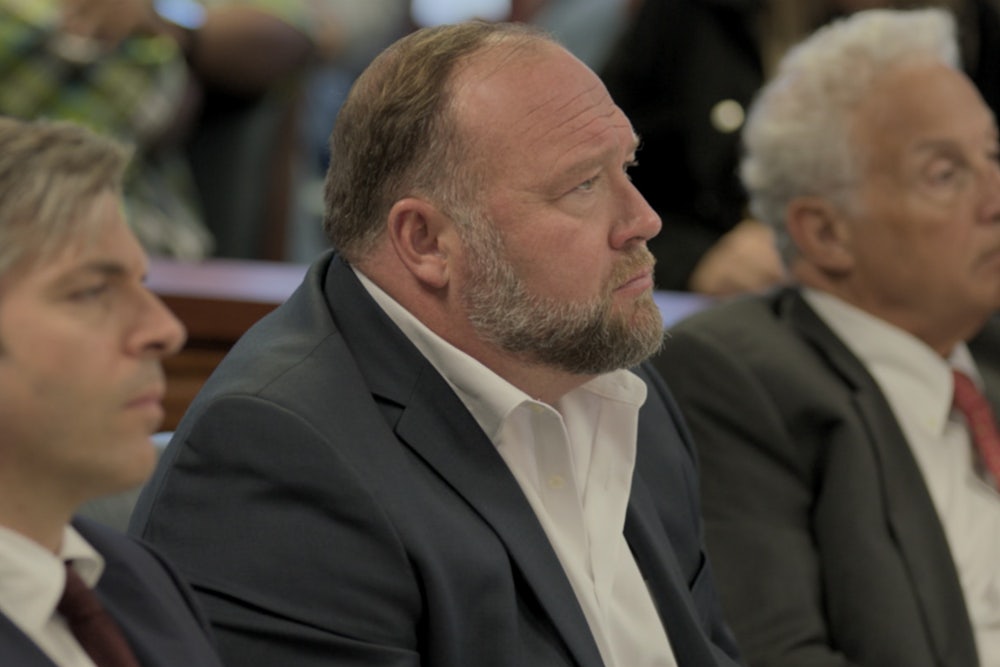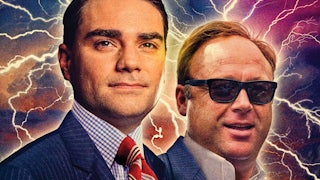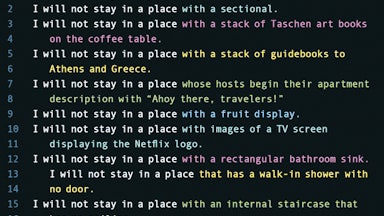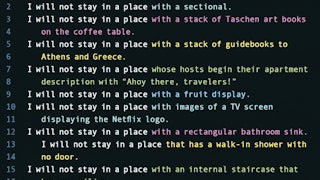There is a scene in Dan Reed’s new documentary about Alex Jones that borders on the tragicomic. It arrives roughly midway through The Truth vs. Alex Jones, a chronicle of two lawsuits brought against Jones by the parents of children murdered in the Sandy Hook Elementary School shooting of 2012, filed after years of abuse from followers of Jones’s conspiracy theory that the massacre was a “hoax” staged to advance a New World Order plot to disarm the American people. The scene takes place on Jones’s first day of testimony in the Travis County, Texas, courtroom where two Sandy Hook parents are suing him for defamation and intentional infliction of emotional distress. Minutes into his questioning, the parents’ lawyer, Mark Bankston, asks Jones a simple question: Does he sell vitamins?
The Infowars host replies, “Yes,” which is where most people would have stopped. But Jones is bad at keeping his mouth shut, including while under oath in a potentially ruinous civil suit, and especially when the subject is his branded line of virility and health supplements. Responding to some primal pitchman’s reflex, Jones barrels ahead as if he were behind his anchor’s desk plugging DNA Force Plus, an enzyme cocktail that he sells for $114.95 a bottle at InfowarsStore.com.
“We have them made by the top lab recognized in the United States,” Jones informs the court. “All we do is put our label on it, and that’s how we know it’s triple-tested, the highest quality—and that’s why people love it. Because it is the best out there. There’s all sorts of crap you can buy at a gas station out there. That’s not what ours is. We buy our PQQ and CoQ10 from the Japanese,” he says, forming a double-OK with his hands for emphasis. “I mean, it’s the best.” He then looks directly at the jury, eyebrows raised, as if he expects them to pull out their wallets, or perhaps applaud his commitment to supply-line excellence. Reed’s panning reaction shot of the unimpressed jurors, a mix of the visibly bored and profoundly baffled, is the closest The Truth vs. Alex Jones comes to deadpan during an otherwise somber two-hour run time.
Alex Jones’s Sandy Hook hoax has been in the news for more than a decade, first as a spectacle of cruelty and conspiracy mongering, and since 2019 as a high-stakes legal battle between Jones and the parents he slandered and harassed. No matter how closely viewers have followed the stages of this story, they are likely to be shaken anew by Reed’s documentary indictment. Making good use of courtroom access, deposition footage, and plaintiff interviews, Reed shows up close the anguish of the parents targeted by Jones and his followers: the death and rape threats, the defaced online memorials, the taunting demands they exhume their children’s bodies to prove they are really dead.
As in his previous documentaries about major crimes, acts of terrorism, and Michael Jackson, in The Truth vs. Alex Jones Reed is more interested in the victims than the monster. The film’s attention to the Sandy Hook parents’ humanity—their suffering, fortitude, and often surprising magnanimity—only emphasizes the incredible smallness of the project served by Jones’s sadism. The documentary makes clear that Jones and his organization used the Sandy Hook hoax theory as rocket fuel for transforming Infowars into a nine- and possibly 10-figure wellness brand, a Goop for preppers, anchored by branded collections of common vitamins and mid-shelf survival gear.
Jones’s move into the supplements industry did not occur until his third decade in media. In January 2011, when I spent a week in Austin reporting one of the first national profiles of Jones, he was still in the early stages of shifting his business model from producing multiple documentaries a year to running an online health store supported by Infowars programming—in particular running coverage of bogus stories. An early test case came in the wake of the Fukushima nuclear disaster of 2011, when Jones sent a crew to coastal California to report on radiation washing up on American shores from Japan. The coverage was designed to drive sales on his first private-label supplement, an iodine dropper called Infowars Life. Reed interviews staffers from the period who narrate how Jones became furious when their reporting did not produce evidence of heightened radiation levels. “Did we think he wanted us to lie? Yeah, it was obvious,” says one former Infowars producer. Jones shut his reporters down but continued to push iodine, routinely consuming the product on air to show viewers how easy it was to protect their thyroids from nonexistent radiation.
Infowars’s supplements business had expanded to multiple products by December 14, 2012, the morning of the Sandy Hook massacre. But if it wasn’t yet clear that the store would make Jones his first $100 million, everybody knew how he’d respond to the news of the most horrific mass shooting in U.S. history. “There is a reported school shooting in Connecticut, one of the states with draconian restrictions on gun ownership,” Jones said, flipping through wire reports of the breaking news. “This is staged. And you know, I’ve been saying for many months, get ready for many mass shootings.”
We know exactly how crucial the Sandy Hook hoax story was to the explosive growth of the Infowars pill business thanks to the incompetence of Jones’s lawyers in both of his trials. During the Texas trial, his attorney, Andino Reynal, accidentally sent Jones’s entire phone history to the opposing lawyers, including evidence undermining key pieces of Jones’s sworn testimony. Not to be outdone, Jones’s lawyer in the Connecticut trial, Norman Pattis, sent opposing lawyers something even more damning: a tranche of emails containing sales analytics of Infowars-branded products through 2014.
Of the information unearthed about Infowars through testimony and discovery in two states, Reed devotes special care to teasing out the implications of the Infowars sales numbers. While crafting conspiratorial content to drive audience share is not illegal—ask Glenn Beck or Rachel Maddow—the question was whether Jones knew he was lying, and the evidence that programming decisions were made to boost pill sales did not help his case. It also went far toward accomplishing what the parents’ Connecticut lawyer Chris Mattei believed to be the trials’ true purpose—“to expose [Jones] to the world as a con man, a fraud.”
The business records reveal Jones’s dedication to the Sandy Hook hoax to be a calculated business decision—and in the short term, a smart and lucrative one. In one example highlighted by Reed, Infowars published an article in September 2014 titled, “FBI says no one killed at Sandy Hook.” This caused a traffic stampede that resulted in a single-day sextupling of sales for the Infowars-branded supplement DNA Force Plus—from $48,000 to $238,000.
The explosion in revenues was carefully noted inside Infowars and served as a template in the years ahead. As Jones’s father, a member of the Infowars business department, told lawyers in his deposition statement, staff closely monitored which stories created dramatic sales spikes, noting, “We like to emulate spikes.” Another deposed member of Infowars’ business team later confirmed that Jones was kept abreast of which segments most dramatically boosted traffic and sales. “The more people in town square, the more go to the shops,” he shrugged. And for much of the last decade, nothing brought people into the Infowars town square like the Sandy Hook hoax theory.
To keep the story at boil and create drama around the narrative, Jones brought in new characters, the way a director might freshen up a fading franchise with a colorful new sidekick. His first hire was a retired Florida school security administrator named Wolfgang Halbig. Like so many of the “independent researchers” Jones features on his show, Halbig arrived as a product of an Infowars feedback loop: His suspicions about “anomalies” in the Sandy Hook story were first piqued by an Infowars article titled, “The Sandy Hook school shooting has more holes in it than Swiss cheese.” After Halbig had established himself as a regular guest “expert” on matters such as the lack of trauma helicopters sent to the crime scene, Jones decided to up the ante. In spring of 2015, he sent Halbig in person to crash Newtown assemblies and school board meetings with demands for public records and various forms of physical evidence that children had been murdered at Sandy Hook Elementary.
Reed’s footage of these interactions can only produce awe at the physical restraint displayed by town officials and parents. Their self-control was tested further when Jones teamed Halbig—who would be named a co-defendant in the Connecticut suit—with an aggressively dim-witted ex–pro wrestler named Dan Bidondi, who somehow made Halbig look like Seymour Hersh. When a lawyer holds up a photo of a crazed-looking Bidondi during a deposition, Jones can’t stifle a guffaw; Bidondi still cracks him up, and it’s obvious that he had hired him as comic relief.
By the time the Connecticut jury delivered the $965 million judgment against Jones in October 2022, he had completed his transformation into a walking infomercial wrapped in a costume-box Gadsden flag. As in the Texas court, his on-air response to the judgment resembled that of an indebted QVC host in danger of missing his daily quota. “Please, go to InfowarsStore.com,” Jones implored from behind his anchor’s desk. “Get Vitamineral Fusion. Get X3.” Those who followed his command were greeted with exciting details about a “1776 Super Sale” that featured 50 percent discounts and opportunities to earn “Double Patriot Points.”
As of this writing, Jones has yet to pay the parents a penny of the more than $1 billion in damages awarded in the two suits. He has instead declared personal and corporate bankruptcy and offered to settle both cases for $85 million disbursed over the next 10 years, plus a percentage of his supplements business in perpetuity. Not surprisingly, the parents have no interest in partnering with Jones in his drop-shipping empire. They are instead pushing to hook Jones for the full amount, which would result in what one parent calls “the total destruction of Alex Jones.” Only the full penalty, says Bankston, the parents’ Texas attorney, can “guarantee his exit from public life.”
Maybe. But neither the parents nor their lawyers suffer any under illusions about what the suits can accomplish in the bigger scheme of things. Reed grants his subjects the necessary time to express the obvious point that, even if Jones is somehow forced back into a graveyard slot on Austin Community TV, it will not reverse the deep social, technological, and psychological forces that have allowed one in five Americans to doubt that Sandy Hook happened. Though Jones possesses a unique charisma—even one of the most active parents in the case, Robbie Parker, confesses to Reed, “You can’t take your eyes off him, you can’t help but follow him around, and I hate to admit that”—the world that he’s helped midwife does not depend on his national presence. Monte Frank, the town of Newtown’s attorney, was bewildered by the first hoaxers he encountered, but by 2021 he recognized their madness as “close to mainstream America now.” “We can solve the Alex Jones problem,” says the parents’ Texas attorney, “but we cannot solve the greater problem that allowed Alex Jones to flourish.”
If that pessimistic assessment was inarguable when Reed finished production on the film, it became more so weeks before its premiere. In February, Open A.I. released the first samples generated by its new text-to-video A.I. program, Sora. The cinema-realistic videos immediately made Jones’s weaponization of “glitches” in CNN interviews with Sandy Hook parents look like the information-war equivalent of a muzzle-loading musket. What will happen when endlessly modified realities can be rendered with hyperrealistic precision and distributed in seconds by Jones’s protégés, those already on the scene and yet to arrive, armed with new conspiracies and new products to sell?






